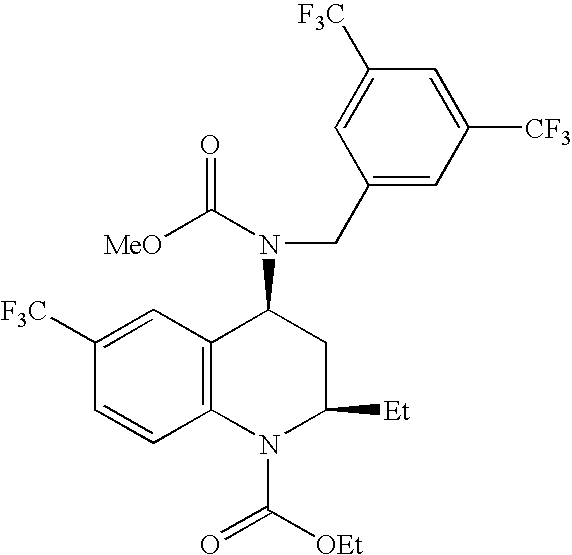Drying of Drug-Containing Particles
a technology of drug-containing particles and dryers, which is applied in the direction of drug compositions, biocide, heterocyclic compound active ingredients, etc., can solve the problems of inefficient solvent recovery, inconvenient drying of drying products, and insufficient uniformity of drying products, so as to facilitate the mass transfer of solvents and reduce the effect of drying time and cos
- Summary
- Abstract
- Description
- Claims
- Application Information
AI Technical Summary
Benefits of technology
Problems solved by technology
Method used
Image
Examples
examples
Dispersion 1
[0085]A solid amorphous dispersion was formed comprising [2R,4S]4-[(3,5-bis trifluoromethyl-benzyl)-methoxycarbonyl-amino]-2-ethyl-6-trifluoromethyl-3,4-dihydro-2H-quinoline-1-carboxylic acid ethyl ester, also known as torcetrapib (Drug 1), having the following chemical structure:
[0086]The dispersion was made by first forming a spray solution containing 4 wt % Drug 1 and 12 wt % hydroxypropyl methyl cellulose acetate succinate (HPMCAS) (AQOAT-MG available from Shin Etsu, Tokyo, Japan) in acetone. The spray solution was pumped using a Bran-Luebbe VE-D31 high-pressure pump to a spray drier (Niro type XP Portable Spray Drier with a Liquid-Feed Process Vessel Model PSD-2) equipped with a pressure nozzle (Spraying Systems SK-71-27). The spray solution was pumped to the spray drier at about 66 kg / hr, with an atomization pressure of about 800 psig (55 atm). Nitrogen drying gas entered the drying chamber at an inlet temperature of 112° C., and a flow rate of about 520 m3 / hr. The...
examples 1-10
[0089]A secondary drying apparatus was fabricated by modifying a vertical process dryer (VPT) obtained from Ekato (Schopfheim, Germany) having a 3-liter capacity and an agitator diameter of 0.2 m. The VPT dryer was modified by fitting it with dual gas inlets near the bottom of the drying chamber so that a stripping gas of dry nitrogen could be fed into the drying chamber. This apparatus was used to remove residual solvent (acetone) from solid amorphous dispersions made by the spray-drying process used to form Dispersion 1. The conditions in the secondary drying apparatus were varied to examine the effects of operating variables on performance. In each example, the drying chamber was charged with about 3 liters (600 g) of the spray-dried Dispersion 1. Hot water was circulated through the jacketed drying chamber to adjust the temperature during each experiment. The drier operating conditions for Examples 1-10 are shown in Table 2.
TABLE 2ChamberFlow rate of NitrogenMixingMixingTemp.Pre...
example 11
[0099]Dispersion 2 was subjected to secondary drying by charging a 50-L capacity Ekato VPT agitated bed vacuum dryer, having an agitator diameter of 0.6 m, and modified to have a stripping gas inlet port with 11 kg of the placebo dispersion. The dryer was operated at a jacket temperature of 50° C., a pressure of 20 mbar, a stir rate speed of 94 rpm, and a nitrogen stripping gas flow of 10.7 SL / min (or 0.97 SL / min-kg).
[0100]Residual acetone was measured using headspace GC as previously described. The results are reported in Table 10. The drying time required to reach 0.1 wt % residual acetone at the 50-L scale was about 1.6 hours.
TABLE 10Time (min)Acetone (wt %)02.10150.98300.63450.38600.24900.111200.051500.031800.02210240
PUM
| Property | Measurement | Unit |
|---|---|---|
| total pressure | aaaaa | aaaaa |
| depth | aaaaa | aaaaa |
| diameter | aaaaa | aaaaa |
Abstract
Description
Claims
Application Information
 Login to View More
Login to View More - R&D
- Intellectual Property
- Life Sciences
- Materials
- Tech Scout
- Unparalleled Data Quality
- Higher Quality Content
- 60% Fewer Hallucinations
Browse by: Latest US Patents, China's latest patents, Technical Efficacy Thesaurus, Application Domain, Technology Topic, Popular Technical Reports.
© 2025 PatSnap. All rights reserved.Legal|Privacy policy|Modern Slavery Act Transparency Statement|Sitemap|About US| Contact US: help@patsnap.com



